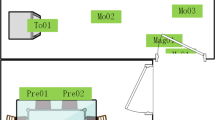Abstract
We propose a system to recognize objects with a camera network in a smart home. Recognizing objects in a home environment from images is challenging, due to the variation in object appearances such as chairs, as well as the clutters in the scene. Therefore, we propose to recognize objects through user interactions. A hierarchical activity analysis is first performed in the system to recognize fine-grained activities including eating, typing, cutting etc. The object-activity relationship is encoded in the knowledge base of a Markov logic network (MLN). MLN has the advantage of encoding relationships in an intuitive way with first-order logic syntax. It can also deal with both soft and hard constraints by associating weights to the formulas in the knowledge base. With activity observations, the defined MLN is grounded and turned into a dynamic Bayesian network (DBN) to infer object type probabilities. We expedite inference by decomposing the MLN into smaller separate domains that relates to the active activity. Experimental results are presented with our testbed smart home environment.
Access this chapter
Tax calculation will be finalised at checkout
Purchases are for personal use only
Preview
Unable to display preview. Download preview PDF.
Similar content being viewed by others
References
Richardson, M., Domingos, P.: Markov logic networks. Machine Learning 62, 107–136 (2006)
Tran, S.D., Davis, L.S.: Event modeling and recognition using markov logic networks. In: Forsyth, D., Torr, P., Zisserman, A. (eds.) ECCV 2008, Part II. LNCS, vol. 5303, pp. 610–623. Springer, Heidelberg (2008)
Pinz, A.: Object Categorization. Foundations and Trends in Computer Graphics and Vision by Now Publishers (2006)
Oliva, A., Torralba, A.: The role of context in object recognition. Trends in Cognitive Sciences 11, 520–527 (2007)
Heitz, G., Koller, D.: Learning spatial context: Using stuff to find things. In: Forsyth, D., Torr, P., Zisserman, A. (eds.) ECCV 2008, Part I. LNCS, vol. 5302, pp. 30–43. Springer, Heidelberg (2008)
Peursum, P., West, G., Venkatesh, S.: Combining image regions and human activity for indirect object recognition in indoor wide-angle views. In: Proceedings of the Tenth IEEE International Conference on Computer Vision (ICCV 2005), vol. 1, pp. 82–89 (2005)
Gupta, A., Davis, L.: Objects in action: An approach for combining action understanding and object perception. In: IEEE Conference on Computer Vision and Pattern Recognition, pp. 1–8 (2007)
Oliver, N., Garg, A., Horvitz, E.: Layered representations for learning and inferring office activity from multiple sensory channels. Computer Vision and Image Understanding 96, 163–180 (2004)
Moeslund, T., Hilton, A., Kruger, V.: A survey of advances in vision-based human motion capture and analysis. Computer Vision and Image Understanding 103, 90–126 (2006)
Liu, J., Luo, J., Shah, M.: Recognizing realistic actions from videos “in the wild”. In: IEEE International Conference on Computer Vision and Pattern Recognition (2009)
Brdiczka, O., Crowley, J.L., Reignier, P.: Learning situation models in a smart home. Trans. Sys. Man Cyber. Part B 39, 56–63 (2009)
Wu, J., Osuntogun, A., Choudhury, T., Philipose, M., Rehg, J.: A scalable approach to activity recognition based on object use. In: IEEE Int. Conf. on Computer Vision, pp. 1–8 (2007)
Park, S., Kautz, H.: Privacy-preserving recognition of activities in daily living from multi-view silhouettes and rfid-based training. In: AAAI Symposium on AI in Eldercare: New Solutions to Old Problems (2008)
Wu, C., Aghajan, H.: User-centric environment discovery in smart home with camera networks. IEEE Transactions on System, Man and Cybernetics, Part A (to appear)
Laptev, I.: On space-time interest points. Int. J. Comput. Vision 64, 107–123 (2005)
Khalili, A.H., Wu, C., Aghajan, H.: Hierarchical preference learning for light control from user feedback. In: Third IEEE Workshop on CVPR for Human Communicative Behavior Analysis (2010)
Author information
Authors and Affiliations
Editor information
Editors and Affiliations
Rights and permissions
Copyright information
© 2010 Springer-Verlag Berlin Heidelberg
About this paper
Cite this paper
Wu, C., Aghajan, H. (2010). Recognizing Objects in Smart Homes Based on Human Interaction. In: Blanc-Talon, J., Bone, D., Philips, W., Popescu, D., Scheunders, P. (eds) Advanced Concepts for Intelligent Vision Systems. ACIVS 2010. Lecture Notes in Computer Science, vol 6475. Springer, Berlin, Heidelberg. https://doi.org/10.1007/978-3-642-17691-3_13
Download citation
DOI: https://doi.org/10.1007/978-3-642-17691-3_13
Publisher Name: Springer, Berlin, Heidelberg
Print ISBN: 978-3-642-17690-6
Online ISBN: 978-3-642-17691-3
eBook Packages: Computer ScienceComputer Science (R0)




